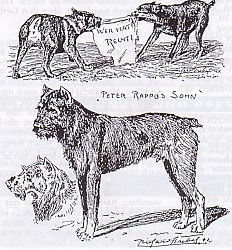| Formation of the PSK |
 |
| Experimental Variations |
| Years ago experimental breedings did not only involve size, but also colours. I remember the experiments with the ('Checkered') Parti colour Miniature Schnauzers in East Prussia by Countess Kanitz, as well as the colour variations found and tried with the Pinschers. There were in part bitter debates over this subject, and many articles for and against were written and published in the PSK monthymagazine. but as these variations were introduced and debated, they also disappeared eventually, and today the recognized colours have been clearly defined and without these variations. But all these experimental types are a part of PSK history, and therefore need to be included. These dogs were kept for their particulare abilities and traits, not colour. The first recognizable Schnauzers were likelyused to hunt bears and wild hogs. Later used for herding, and then kept in barns where they proved very efficient at eliminating rats and mice, earning the title of "Ratcatcher or Ratter", as well as protecting the family by alerting them of strangers. In the very first Pinscher and later Pinscher-Schnauzer Klub breed record books, all dogs were recorded according to "size", however, they also cam in "all" variations of colour..... |
| In the early years "all" correspondance was still handwritten by the officials themselves, in most cases, in their own (rather than print). The first breed records were not only written by hand in "Calligraphy" with a carbon copy underneath to make a second set, but also showed a rich variety of colours among the coarse variation, that included much more then "basic" colours. The "Key" factor was the texture of the coat. In 1920 roughly 320 schnauzer puppies were registered with the PSK. Both Josef Best and Max Kamp rant the PSK from their homes. Further breed records were handwritten by two regular PSK members under the direction of Heinrich Held, who also ran the PSK activities from his own home. Finally in 1952, the first official PSK office was opened consisting of one office director and 2 secretarial clerks. In their new office, the secretaries took over the duties of recording the breed records, now with typewriters, and all documents and letters were now typed rather than handwritten. In 1964 the PSK registered 1100 Black and 600 Salt & Pepper Minis, primarily out of Eastern Germany. In 1970 the PSK moved again, this time to the home of Heinz Hoeller. The original outdated office was tehn upgraded with modern furniture, electric typewriters, photocopiers, and other updated technology. Their first computer was purchased in 1971, and after some difficulty adjusting and learning how to use it, this new technology allowed everything to run with speed, ease and accuracy. Marga Hoeller (wife of Heinz Hoeller) spent the next 20 years directing and running the PSK office, with the help of two hired assistants. In 1991 the PSK office moved to an independant office housed in an old but renovated building in Remscheid, where the PSK headquarters are still located today. The official PSK emblem colours were blue and yellow. Honourable officials were awarded various valuable symbols and momentos in jewwlry form after years of dedicated service. |